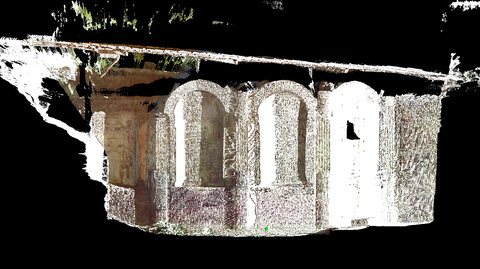By Charlotte Brookins
Myat Aung, a PhD student in the School of Art and Art History, has combined archeological research with the digital humanities to reconstruct natural and artificial grottoes from Ancient Rome as part of her dissertation.
Aung is in her final year of the program, which is housed in the College of Liberal Arts and Sciences at the University of Iowa. She specializes in Ancient Roman art and architecture.
Through the use of laser scanning and 3D digital modeling, Aung hopes to contextualize the historical environments by allowing people of the modern world to share in the sensory experience.
“I look at how art, architecture, water, and other natural features of these environments worked together to impact the human experience, as well as how ancient visitors interacted with these locations,” Aung describes. “I’m looking at them from a holistic view because these spaces are mostly in ruinous states, sometimes with things built over them, so this is a way for me to document the ancient world and also reconstruct it so modern audiences can experience and understand what the ancient visitors would have encountered.”

To create the reconstruction (shown below), Aung traveled to Castellammare di Stabia in southern Italy in 2017 as an independent researcher with the University of Maryland to document the Villa San Marco, a Roman coastal town on the Bay of Naples.

Using LiDAR (light detection and ranging) technology, Aung scanned the site, which she later used in one of her digital 3D constructions. She also recorded sound on-site to accompany the scan and allow for sensory immersion.
“Monuments are becoming more and more digitized these days, and digital cultural heritage has become a big incentive for world heritage programs,” explains Aung. “People are trying to find ways to preserve ancient sites where structures are frequently unstable and, at times, blocked out, and you can’t really see what people experienced then. I’m trying to recapture these past experiences so that modern viewers can have a sense of what’s happened in the past.”
Aung, who came to Ripon College in Wisconsin from Myanmar in 2012, said she chose to attend graduate school at the University of Iowa because of its unique offerings in art, art history, and technology, as well as the close-knit nature of the community.
“The university is very open to ideas, and I’m able to explore different kinds of technologies with these digital models, something that I feel not a lot of art history departments have access to,” says Aung. “Everyone is so welcoming and supportive.”
Aung is especially grateful to her advisor Brenda Longfellow, who has played a major role in Aung’s research and her studies here at the university. Aung says she is looking forward to finishing up the last year of her PhD program and finalizing the research she has worked hard on.